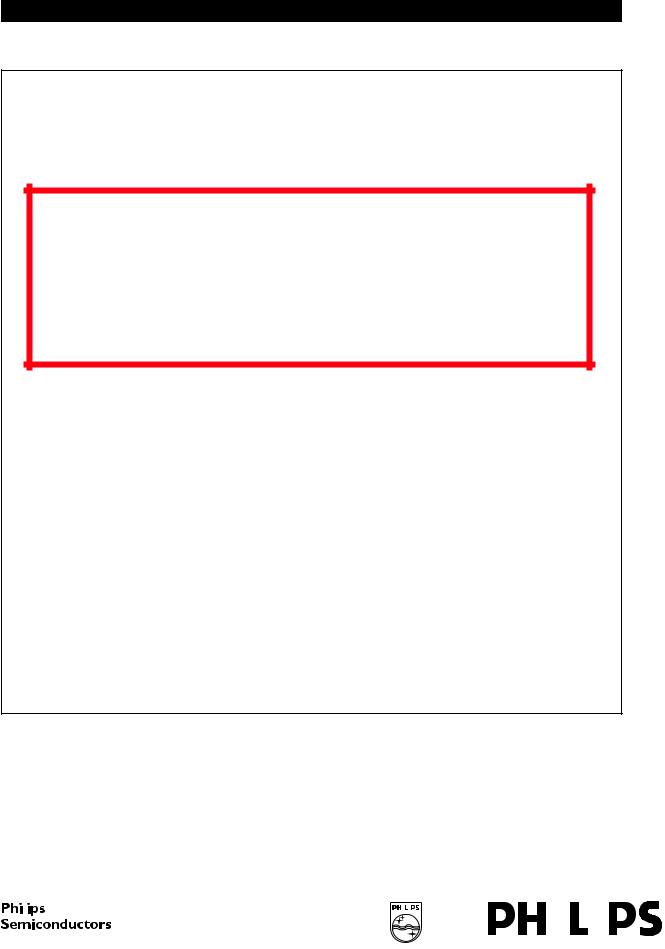Philips 74HCT273U, 74HCT273PW, 74HCT273NB, 74HCT273N, 74HCT273DB Datasheet
...
INTEGRATED CIRCUITS
DATA SHEET
For a complete data sheet, please also download:
∙The IC06 74HC/HCT/HCU/HCMOS Logic Family Specifications
∙The IC06 74HC/HCT/HCU/HCMOS Logic Package Information
∙The IC06 74HC/HCT/HCU/HCMOS Logic Package Outlines
74HC/HCT273
Octal D-type flip-flop with reset; positive-edge trigger
Product specification |
|
September 1993 |
|||||
File under Integrated Circuits, IC06 |
|
|
|
|
|
|
|
|
|
|
|
|
|
|
|
|
|
|
|
|
|
|
|
|
|
|
|
|
|
|
|

Philips Semiconductors |
Product specification |
|
|
|
|
Octal D-type flip-flop with reset;
74HC/HCT273
positive-edge trigger
FEATURES
·Ideal buffer for MOS microprocessor or memory
·Common clock and master reset
·Eight positive edge-triggered D-type flip-flops
·See “377” for clock enable version
·See “373” for transparent latch version
·See “374” for 3-state version
·Output capability; standard
·ICC category: MSI
GENERAL DESCRIPTION
The 74HC/HCT273 are high-speed Si-gate CMOS devices and are pin compatible with low power Schottky TTL (LSTTL). They are specified in compliance with JEDEC standard no. 7A.
The 74HC/HCT273 have eight edge-triggered, D-type flip-flops with individual D inputs and Q outputs. The common clock (CP) and master reset (MR) inputs load and reset (clear) all flip-flops simultaneously.
The state of each D input, one set-up time before the LOW-to-HIGH clock transition, is transferred to the corresponding output (Qn) of the flip-flop.
All outputs will be forced LOW independently of clock or data inputs by a LOW voltage level on the MR input.
The device is useful for applications where the true output only is required and the clock and master reset are common to all storage elements.
QUICK REFERENCE DATA
GND = 0 V; Tamb = 25 °C; tr = tf = 6 ns
SYMBOL |
PARAMETER |
CONDITIONS |
TYPICAL |
UNIT |
||||
|
|
|||||||
HC |
HCT |
|||||||
|
|
|
|
|
|
|||
|
|
|
|
|
|
|||
tPHL/ tPLH |
propagation delay |
CL = 15 pF; VCC = 5 V |
|
|
|
|||
|
|
CP to Qn |
|
15 |
15 |
ns |
||
|
|
|
|
15 |
20 |
ns |
||
|
|
MR |
to Qn |
|
||||
fmax |
maximum clock frequency |
|
66 |
36 |
MHz |
|||
CI |
input capacitance |
|
3.5 |
3.5 |
pF |
|||
CPD |
power dissipation capacitance per flip-flop |
notes 1 and 2 |
20 |
23 |
pF |
|||
Notes
1. CPD is used to determine the dynamic power dissipation (PD in mW): PD = CPD ´ VCC2 ´ fi + å (CL ´ VCC2 ´ fo) where:
fi = input frequency in MHz
fo = output frequency in MHz
å (CL ´ VCC2 ´ fo) = sum of outputs
CL = output load capacitance in pF
VCC = supply voltage in V
2. For HC the condition is VI = GND to VCC
For HCT the condition is VI = GND to VCC - 1.5 V
ORDERING INFORMATION
See “74HC/HCT/HCU/HCMOS Logic Package Information”.
September 1993 |
2 |

Philips Semiconductors Product specification
Octal D-type flip-flop with reset; |
74HC/HCT273 |
|||
positive-edge trigger |
|
|
|
|
|
|
|
|
|
|
|
|
|
|
PIN DESCRIPTION |
|
|
|
|
|
|
|
|
|
PIN NO. |
|
SYMBOL |
NAME AND FUNCTION |
|
|
|
|
||
1 |
|
|
|
master reset input (active LOW) |
|
MR |
|
||
2, 5, 6, 9, 12, 15, 16, 19 |
|
Q0 to Q7 |
flip-flop outputs |
|
3, 4, 7, 8, 13, 14, 17, 18 |
D0 to D7 |
data inputs |
||
10 |
GND |
ground (0 V) |
||
11 |
CP |
clock input (LOW-to-HIGH, edge-triggered) |
||
20 |
VCC |
positive supply voltage |
||
Fig.1 Pin configuration. |
|
Fig.2 Logic symbol. |
|
Fig.3 IEC logic symbol. |
|
|
|
|
|
September 1993 |
3 |
